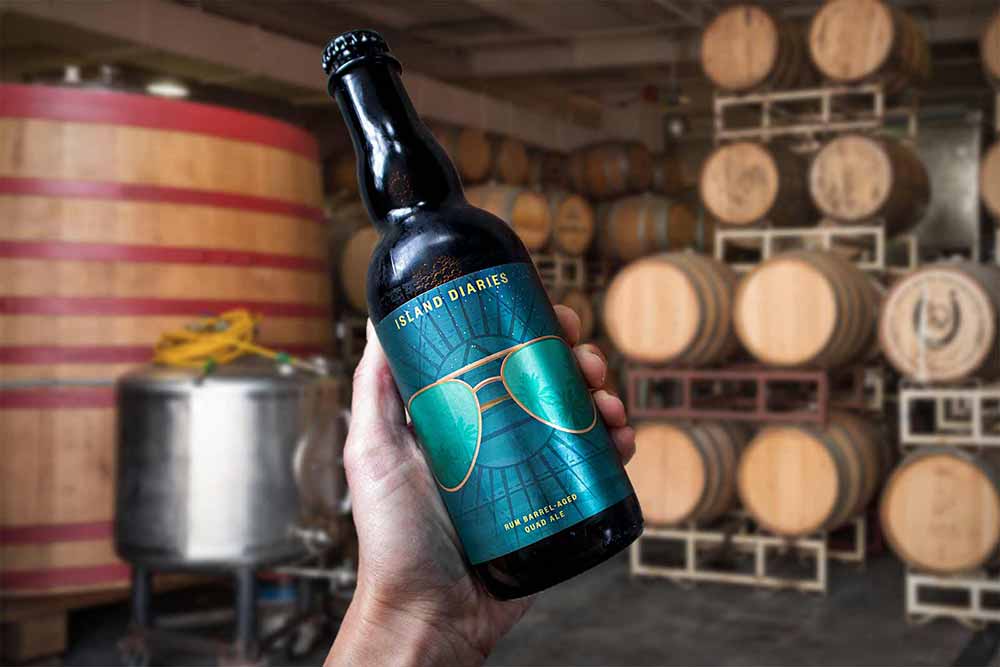Shop
What Is a Belgian Quad?
Four times the fun.
Looking for More Stories in This Series?
With its signature rich, malty flavor, medium bitterness, and impressive ABV, the Belgian quad is a beer that has literally stood the test of time. A subcategory of Belgian strong ale, the quad or “quadrupel” has a fascinating history and delectable flavor profile. Both make learning about this storied European style worthwhile. And, of course, excellent reasons to try a few.
A Brief History of Belgian Quads Starts with the Trappists

The Belgian quad has roots dating back to the sixth century in Europe when monks brewed beer.
“Historically, a quadrupel is a Trappist style of brewing,” says Rick Debar, director of operations at Brewery Ommegang in Cooperstown, NY, well-known for its Belgian-style quadrupel ale called Three Philosophers.
What exactly is a Trappist beer? To answer that, we need a bit of a history lesson.
The Trappists, also known as the Order of the Cistercians of the Strict Observance, emerged after the collapse of the Roman Empire in the fifth century.
During this time, the Catholic Church underwent a period of significant change. And St. Benedict emerged with a set of rules for monastic life. Known as the Rule of St. Benedict, these regulations were adopted by different monasteries and spread across various parts of Europe.
As monasteries changed over time, some loosened their adherence to the original rules. But some monks yearned for the return of the stricter Rule of St. Benedict. For instance, those who founded The Abbey of Citeaux in 1098 in southern France. These Cistercians are the ancestors of today’s Trappists.
Accordingly, the term “Trappist” comes from a Cistercian monastery in Normandy, France, called La Grande Trappe Abbey. Here, during the seventeenth century, a movement started to return to this austere way of life and religious practice. Those involved earned the nickname “Trappists.”
The name stuck.
Okay, But Why Are the Trappists so Important? And What Do They Have to Do with Quads?

Photography courtesy of John Murphy
Because quadrupels are a type of Trappist beer!
Historically, Trappists began brewing in monasteries as a way to create potable water. But it was also a means to generate income for the monastery and local community.
Monasteries, in general, brewed beer as early as the sixth century. Trappists, like those at La Grande Trappe, are on record as operating a brewery around 1685.
“A true Trappist quadrupel carries the distinction of having been warm-fermented and bottle conditioned within the walls of the monastery brewing operations,” says Debar.
Over time, the tradition of brewing within monasteries grew.
Famous Belgian Trappist beers, including dubbels and tripels, began to emerge in the mid-1800s from monasteries such as Westmalle and Westvleteren (a monastery that makes one of the rarest beers in the world today).
However, the quadrupel wouldn’t make an appearance until 1991 when De Koningshoeven Brewery, a Dutch Trappist Brewery in the Netherlands, brewed the first quad called La Trappe Quadrupel.
Though technically a brewery in the Netherlands brewed the first quadrupel, the majority of modern quads are made with Belgian yeast. And it is commonly understood that quads are a beer of Belgian origin.
How the Belgian Quad Came to America

Photography courtesy of Spencer Brewery
The first Trappists fled to America in 1803 to escape Napoleon’s persecution in Europe. They brought their brewing traditions with them, first to the Gethsemani Abbey in Kentucky and later across the country.
Today, there are Trappist monasteries throughout the United States. But only one was recognized by the International Trappist Association: Saint Joseph’s Abbey in Spencer, MA, which brewed Spencer Monks’ Reserve Ale, a Trappist quadrupel. However, in 2022, after much reflection, the only Trappist brewery in the U.S. closed its doors.
Still, many consider the inaugural La Trappe Quadrupel of the Netherlands as helping the Belgian quad gain roots in America and beyond. Since then, this beer has influenced a generation of brewers. Inspired by the complex flavors from the unique Belgian ingredients in quadrupels, brewers across the United States have dabbled in creating delicious offerings of their own.
Belgian Malt and Candi Sugar Define Belgian Quads

Photography courtesy of Drake’s Brewing Co.
Even though they often clock in at 9.1%-14% ABV, brewing quadrupels is not very different from brewing other beers. It’s the ingredients that truly define this style.
“The main difference, and what makes a quad, is you are using Belgian malts and Belgian yeast,” says Travis Camacho, director of barrel aged and specialty beverage for Drake’s Brewing in San Leandro, CA, who says the brewery has a history of brewing quads as a barrel-aged offering.
As dark beers, quads walk a very fine line between complexity and balance of flavors. Camacho enjoys brewing them because the sweet, fruity, dark crystal malts change as they age.
Similarly, at Brewery Ommegang, malts are an essential part of their Three Philosophers quad. “Quads typically require fifty percent more malt per hectoliter (hl) than standard beers. We also use a significant amount of roasted malt to create the mouthfeel and flavor profile of the beer,” says Debar.
Another characteristic of Belgian quads is the fermentable sugars.
“Quads typically use some sort of one hundred percent fermentable sugar in addition to the malt bill—usually Belgian candi sugar,” says former Director of Production for The Bruery in Placentia, CA, and current Everywhere Co-Founder Jeremy Grinkey.
The Bruery has made several quads, including the seasonal Seven Swans a Swimming, Quadrupel Tonnellerie, and Quad Kisses.
Sugar comes in different grades, which Grinkey says usually relates to its color or source.
But when it comes to Quads, it’s not just the Belgian malt and candi sugar that’s important. It’s also Belgian yeast.
Belgian Yeast Is Also Very Important for a Quad

Photography courtesy of Drakes’ Brewing Co.
“Belgian yeast is known for being very flavorful and, depending on fermentation, it can produce a ton of fruity esters and spicy phenols which influence the beer quite a bit,” says Camacho. “Other yeasts make esters and phenols, but none to the level and flavor profile of Belgian yeasts. That’s why you can’t brew a Belgian-style beer without Belgian yeast—it’s probably one of the most important parts.”
He adds that substituting for a non-Belgian yeast would alter the flavor completely.
Grinkey agrees, “Quads are uniquely Belgian, and I believe they are best done with a nod to the old world. Belgian yeast is key, in my opinion. Although it can be made in several ways, it is not a Quad if it is not brewed using Belgian yeast.”
At Ommegang, Debar says he ferments at higher temperatures over ten days to tease out the fruity esters they desire from the yeast. During post-package fermentation or bottle conditioning, they hold the beer in a warm cellar for an additional ten to fourteen days before being released.
Camacho looks for the art of classic Belgian yeast playing off the darker crystal malts when brewing a quad.
“Generally, the Belgian malts are a little sweeter and fruitier, and the yeasts are fruity and spicy. To balance that out, you want the beer to perhaps be a little bit drier than you would a normal stout by mashing in low and using candi sugar,” he says. “I like to use even darker crystal malt than may be traditional to get more of those subtle fruity coffee notes, instead of just the dark fruit, plums, and figs that might be more traditional.”
What’s the Typical Quad Appearance, Aroma, and Flavor?

Photography courtesy of The Bruery
Ranging from amber to dark brown in color, quadrupels have a distinct flavor all their own.
Debar says quad drinkers can expect a rich, roasted, malty character with a medium to full body, along with some fruity notes, including spicy darker fruits.
“Our well-loved Three Philosophers is a quadrupel blended with a touch of cherry,” says Debar. “Each January brings a special release.”
Debar explains that quads have a relatively low perceived hop character but require a fair amount of bitterness to counter the residual sweetness.
Flavors from dark fruits such as figs, raisins, dates, and plums are often noted, adds Grinkey, alongside good Belgian yeast characteristics.
“I like the relative lighter body to alcohol strength,” says Grinkey, who also notes that the history of the beer makes them even more enjoyable. “Belgian beers are some of the oldest beer styles and have been hugely inspirational to American craft brewers.”
Today, with such great access to Belgian quads, Camacho urges people to take advantage of the offerings.
“I would encourage people who are not as familiar with the style or maybe not familiar with the classic examples to go grab a couple of bottles because they are damn fine beers,” he says. “Barrel-aged quad is life.”
How to Drink a Belgian Quad and Some Good Belgian Quads to Enjoy

Photography courtesy of Brewery Ommegang
Belgian quads should be enjoyed chilled, either straight from the bottle or poured from the tap in a tulip-shaped glass. As a hearty beer, they can be drunk on their own or paired with cheeses such as Gouda.
La Trappe Quadrupel – Bierbrouwerij De Koningshoeven
Berkel-Enschot, Noord-Brabant, Netherlands
This is the original that started it all. Brewed by Brewery de Koningshoeven in the Netherlands, La Trappe Quadrupel has a full, mild, and pleasantly bitter taste – 10% ABV.
Three Philosophers – Brewery Ommegang
Cooperstown, NY
A blend of Belgian-style quadrupel and Belgian kriek from Brewery Ommegang, Three Philosophers has a malty depth and gentle sweetness enhanced by sparkling carbonation and a touch of cherry – 9.7% ABV.
Quad Kisses – The Bruery
Placentia, CA
The Bruery crafts Quad Kisses true to its name, with a tetrad of barrel-aging, including bourbon, rye whiskey, scotch, and rum barrels to give this ale an “unfamiliar complexity all its own,” according to the beer’s Untappd description – 13.1% ABV.
Island Diaries – Drake’s Brewing Company
San Leandro, CA
Drake’s makes a barrel-aged Belgian-style quadrupel called Island Diaries with notes of coconut, banana bread, and rum spice – 10% ABV.




